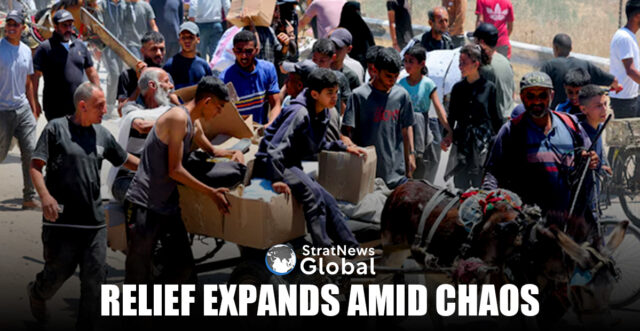The U.S.-backed aid group in Gaza opened a third distribution site on Thursday and announced plans for more in the coming weeks, as a surge of Palestinians seeking desperately needed supplies continues to strain the system’s capacity.
The Gaza Humanitarian Foundation, a private group backed by the United States and endorsed by Israel, began operations this week, but the launch was marred by tumultuous scenes on Tuesday when thousands rushed the fences and forced private security contractors to retreat.
The chaotic start to the operation has raised international pressure on Israel to get more food in and halt the fighting in Gaza, with new U.S. proposals on the table that Hamas said it was studying.
On Thursday, GHF said it had opened a third distribution hub in Gaza and had so far supplied a total of just over 1.8 million meals. More sites are due to be opened in the coming weeks.
UN Criticises New System
The new system has been heavily criticised by the United Nations and other aid groups as an inadequate and flawed response to the humanitarian crisis left by Israel’s 11-week blockade on aid entering Gaza.
Wessam Khader, a 25-year-old father of a three-year-old boy, said he had gone to a site near Rafah, despite widespread suspicions of the new system among Palestinians and warnings from militant group Hamas to stay away.
He said he had gone every day since Tuesday but only obtained a 3 kg (6.6 pounds) package containing flour, canned sardines, salt, noodles, biscuits and jam on the first day.
“I was driven by the hunger, for several weeks we had no flour, we had nothing in the tent,” he told Reuters by telephone from Rafah. “My son wakes every day asking for something to eat, and I can’t give him.”
When he arrived with his father and brother, there were thousands there already and no sign of the identification process that Israeli officials had promised to screen out anyone considered to have links to Hamas.
“I didn’t see anything, no one asked me for anything, and if there was an electronic gate or screening, I think it collapsed under the feet of the crowds,” he said. The gates, the wire fences were all brought down, and even plastic pipes, metal sheets and fencing material were carried off.
“People were hungry and they took everything at the site,” he said.
Earlier this week, GHF said it had anticipated such reactions from a “distressed population”, but the United Nations has said the amount of aid coming in remains far below what is required to relieve the risk of famine for more than 2 million people in the enclave.
U.N. officials have said that prior to the war, at least 500-600 trucks of aid and commercial goods a day were required to supply Gaza. U.N. Middle East envoy Sigrid Kaag has described the amount of aid Israel had so far allowed the U.N. to deliver as “comparable to a lifeboat after the ship has sunk” when everyone in Gaza was facing the risk of famine.
For Palestinians in northern Gaza, cut off from distribution points in the south, even the limited amount of aid coming in through GHF or through trucks from the U.N. and other aid groups remains out of reach.
“We see videos about the aid, and people getting some, but they keep saying no trucks can enter north where we live,” said Ghada Zaki, a 52-year-old mother of seven in Gaza City, who told Reuters via chat app.
Air Strikes
Israel imposed the blockade at the beginning of March, saying supplies were being stolen by Hamas and used to entrench its control over Gaza. Hamas denies stealing aid and says it has protected aid trucks from looters.
Even as thousands made their way to the distribution site, Israeli jets continued to pound areas of Gaza, killing at least 45 people on Thursday, including 23 people in a strike on the Bureij camp in the central Gaza Strip, Palestinian medical workers said.
The Israeli military said it hit dozens of targets in Gaza overnight, including what it said were weapons dumps, sniper positions and tunnels.
Gaza’s Hamas-led interior ministry said several police officers were killed by an Israeli strike as they confronted thieves in Gaza City.
Speculation around a possible ceasefire agreement grew after U.S. President Donald Trump’s special envoy Steve Witkoff said the White House was preparing a draft document that could provide the basis for an agreement.
However, it was unclear what changes to previous proposals were being considered that might overcome the deep differences between Hamas and Israel that have stymied previous attempts to restore a ceasefire that broke down in March after only two months.
Israel has insisted that Hamas disarm completely and be dismantled as a military and governing force, and that all the 58 hostages still held in Gaza must come back before it will agree to end the war.
Hamas has rejected the demand to give up its weapons and says Israel must pull its troops out of Gaza and commit to ending the war.
Israel has come under increasing international pressure, with many European countries that have normally been reluctant to criticise it openly demanding an end to the war and a major relief effort.
Israel launched its campaign in Gaza in response to the devastating attack in southern Israel on October 7, 2023, that killed some 1,200 people and saw 251 taken hostage into Gaza, according to Israeli tallies.
The campaign has killed more than 54,000 Palestinians, Gaza health officials say, and left the enclave in ruins.
(With inputs from Reuters)





